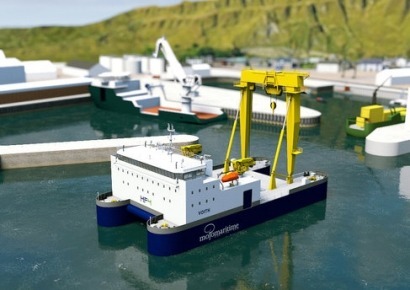
Project Management and Engineering Consultancy Mojo Maritime has concluded the design of the advanced DP system in collaboration with GE and Voith Turbo and tested it in DP simulations and ship-handling simulators. These systems provide an accurate model of vessel DP and handling capability. The aim was to develop a vessel with the ability to hold station to a tight footprint in currents of up to 10 knots – exceeding the capabilities of any vessels currently on the market and providing major risk and cost reductions across a range of industries and operations.
The simulation tools used to design the DP system for the HF4 were based on collecting and analysing turbulence data from the Inner Sound, Pentland Firth. The current speeds and directions at this site fluctuate dramatically, making them very difficult for existing DP systems to cope with due to the changing variables, thereby confusing the DP software. Scenarios were based on a wide range of real-life operational and worst case situations, including the failure of a thruster during operation – the worst single-point failure expected when operating in harsh environments.
The final results were impressive with the vessel demonstrating excellent station keeping at 10 knots even with the effects of turbulence.
“The vessel was able to maintain station even in very extreme environmental conditions - 10 knots of currents combined with 50 knot winds and 3 metre waves” said Toby Bates, DP Training and Development at Mojo Maritime. “We then failed the thrusters and systems and amazingly the vessel lost a small amount of position yet recovered within seconds.”
The outstanding performance of the vessel means that it has the potential to deliver techno-economic advantages to a range of applications in the renewable energy sector. These include tidal energy operations where the vessel will have the capacity to operate through neap and spring tides, even in the most aggressive sites such as The Pentland Firth and Raz Blanchard. This in turn will have a major positive effect on operability and ultimately installation costs and production. Additionally the vessel can provide rapid response on operations and maintenance (O&M) interventions without having to wait for neap tides.
With regard to offshore wind, the vessel can demonstrate better control and safety during cable laying and trenching operations. The DP system has been developed to provide excellent stability and has a unique deck layout for better cable control and handling in harsh environmental conditions with a low risk of excursion. The vessel’s unique bespoke Rapid DP system means it can undertake 10 crew transfers an hour compared to 2 per hour for a conventional vessel. This will lead to a much higher uptime on technician’s hours.
“She is extremely rapid in acceleration, deceleration and turning and very stable in all conditions” added Richard Parkinson, Managing Director of Mojo. “Compared to a conventional vessel she is able to operate with current and wind from any direction, which makes set up on site much quicker and much more flexible. We are planning for the first vessel to be delivered in June 2016.”
Toby Bates will be presenting the vessel at the upcoming SMM Conference in Hamburg where the vessel will feature on the Voith Simulator on stand 414, Hall A4, 9-12th September 2014. Toby and the HF4 simulator will also be at the WindEnergy Hamburg conference, Hall B3, stand 218, 23-26th September 2014.
For additional information:

